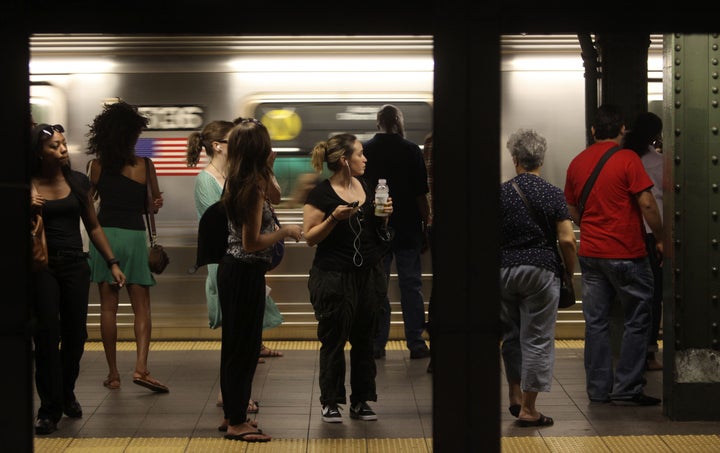
With the Democrats licking their wounds and the Republicans and Tea Partiers licking their chops, it is time to trot out some old ideas for funding the construction of public transportation in LA.
There are no new ideas, just recycled old ones. Inspired by the mid century unions which built housing for their members, my latest epiphany concerns the feasibility of using union and public pension fund money to fund LA's overdue public transportation projects. For starters I passed the idea by LAANE's executive director, and the chief deputy to María Elena Durazo, Executive Secretary -- Treasurer of the Los Angeles County Federation of Labor. Both seemed to think I'm a crackpot. Maybe so, but good ideas come from all over, and several other local civic leaders have encouraged me to keep at it.
If you care about LA and mobility around the region you have probably heard something about the 30/10 Initiative and the 12 transit projects the Mayor, Metro, and others have been working to realize for a year or more through some combination of federal transportation grants and loans.
Let's face it, after the midterm election we're in a new world. Even though the new Congress is sure to include public transportation enthusiasts from both sides of the aisle, advancing 30/10 has just gotten that much harder. In all likelihood, support for the plan will now come at best in piecemeal fashion, leaving many Angelenos gasping for the hoped for mobility solutions that 30/10 promised. What is more, the public remains divided over anything that is going to cost them more at tax time. It is true that County voters passed the half cent transportation sales tax known as Measure R in 2008, but who is to say they will support another tax or surcharge or whatever name we slap on it to accelerate the 30/10 projects. This reality presents no small obstacle to 30/10 and frankly always did.
But what if the big unions in LA and elsewhere stepped up and said they are going to invest some of their pension money in Metro's building project? Every investment needs a quid pro quo and with unemployment in LA still at near record highs, jobs are the quid -- or is it quo? -- in this deal.
Sure, some will say Big Labor is just creating higher priced union jobs for their members with this idea. Yes, that's one of the outcomes and perhaps the key reason the LA Labor Federation's Durazo and national labor leaders like AFL-CIO President Richard Trumka should care about and look into it. But that is not the only thing the plan does. With more public transportation projects funded sooner, the plan benefits all of us who long for the day we can ride the Wilshire Subway from downtown to the VA, light rail from the South Bay to Figueroa or some form of fast public transportation from the San Fernando Valley to the Westside.
Union and public pension fund investment in public transportation may be the economic shot in the arm LA needs, but President Obama and a divided Washington just can't, or won't, deliver.
To understand the feasibility of all of this I spoke with an investment management advisor from the Union Labor Life Insurance Company (Ullico). Founded in 1927, Ullico offers insurance, commercial lines of credit and other investment products and services.
As of 2008, Ullico's J for Jobs Fund, a product of the company's Real Estate Investment Group had invested $2.3 billion in a variety of union labor real estate construction projects. According to REIG News these investments include LA Live-Phase II, the Red Building in West Hollywood and Horizon at Playa Vista; as well as hotels, casinos and office buildings in New York, Las Vegas and elsewhere.
Though I am still struggling to find out what sort of returns investors actually realized on this pooled real estate investment fund, given the slump in the market I'd be surprised if the unions saw the promised and hoped for mid-teen percentage returns.
Ullico told me they are just now starting to raise money for a new $750 million to $1 billion infrastructure fund and that in principle this fund might include public transportation infrastructure investment. Ullico says "might" because frankly other sorts of infrastructure investments like power plants may produce better investment returns than public transportation, which tends require a subsidy to operate once built. And this is to say nothing of investors' well founded concern that large infrastructure projects tend to run over budget as in the case of NY/NJ's ARC transit tunnel, New York's Second Avenue Subway and Boston's Big Dig. One seasoned Wall Street municipal finance expert told me that while he likes my idea, Wall Street or the unions or whoever is investing needs details and a set of real cost projections. In other words, the deal has to pencil out or there is none.
Well no one ever said doing 30/10 or a union funded investment in public transportation infrastructure construction would be easy but isn't it worth a try?
On a recent conference call with the Mayor and the Deputy Mayor for Transportation both said my idea wouldn't work. But when I persisted, asking whether they had actually approached Labor's Durazo with the idea of using union pension money to help finance part of 30/10 the Mayor responded, "no."
While I can appreciate the unions wanting the largest possible return on investment, if you don't have a job generating income to invest in your pension then the issue of higher returns is moot. In this idea I see an opportunity to put thousands of union workers back to work building stuff that LA needs, as opposed to another casino on the Las Vegas strip. Even if those Las Vegas construction jobs are union work, no LA union member needs to be investing in them.
Industry practice says lower interest paying infrastructure projects like the Wilshire subway can be bundled together with other projects paying better returns, for a decent average return. Who knows? Maybe if done right, the projected returns of my Union Public Transportation Investment Fund (UPTIF) will appeal to non-union investors as well.
Durazo and Trumka, I hope you are reading. UPTIF is an idea worth considering.
